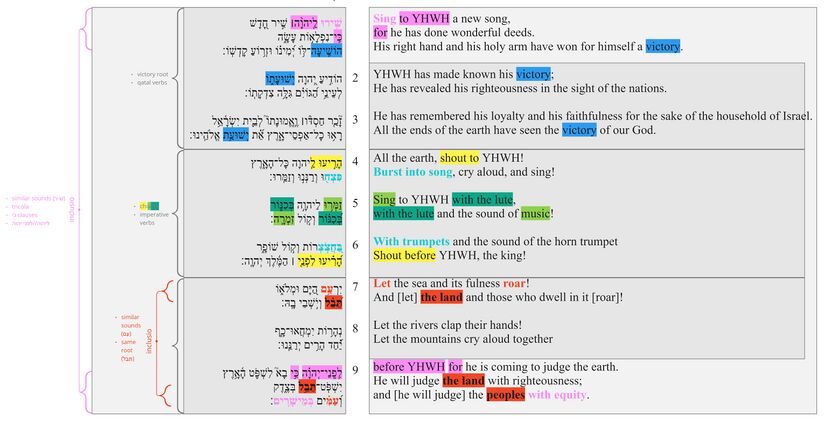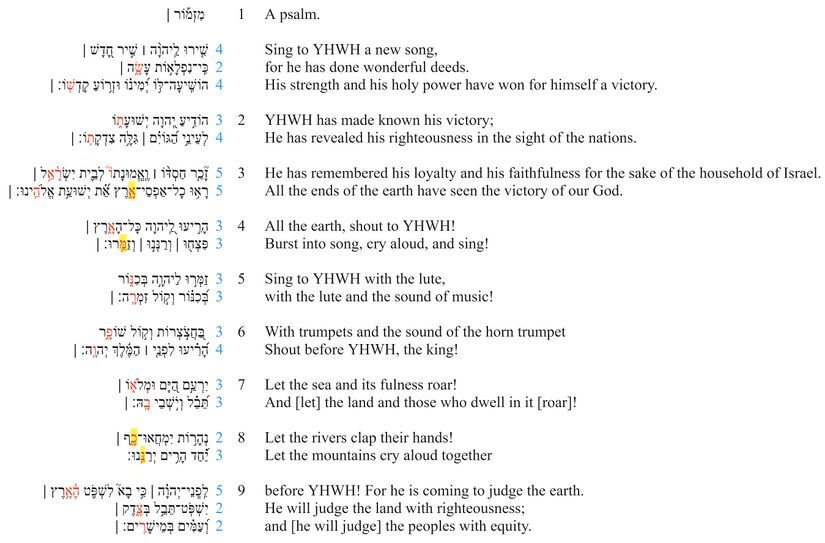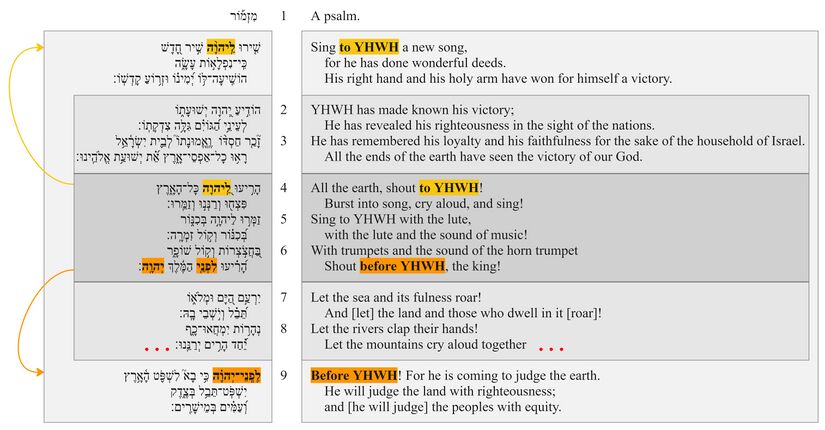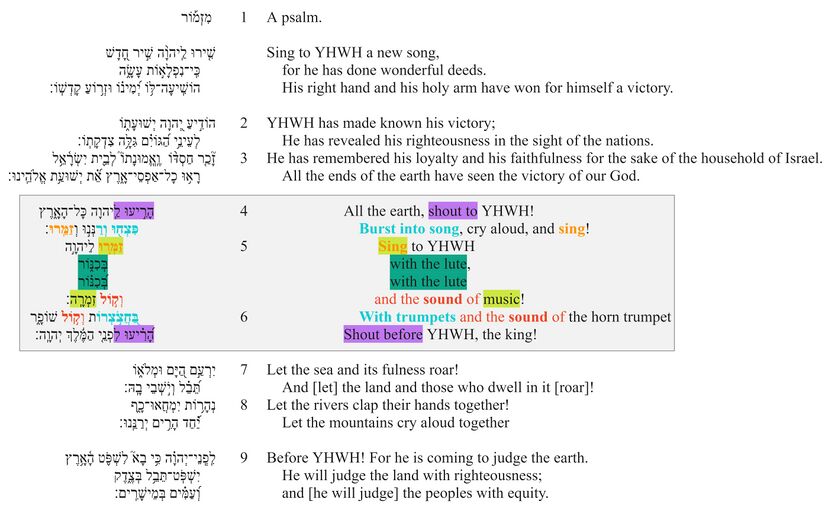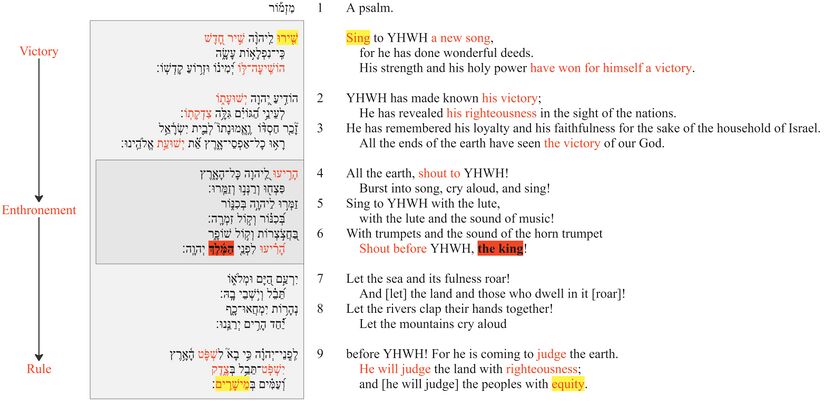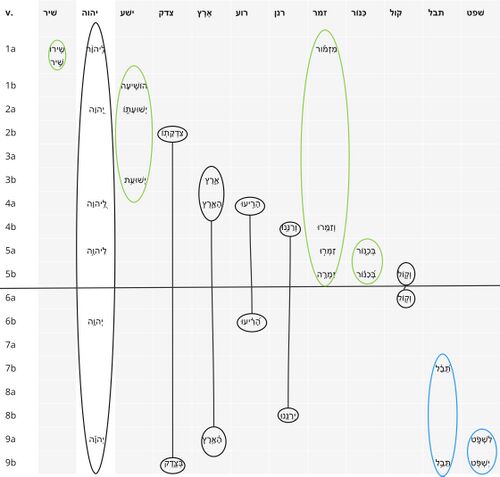Psalm 98 Poetics
About the Poetics Layer
Exploring the Psalms as poetry is crucial for understanding and experiencing the psalms and thus for faithfully translating them into another language. This layer is comprised of two main parts: poetic structure and poetic features. (For more information, click 'Expand' to the right.)
Poetic Structure
In poetic structure, we analyse the structure of the psalm beginning at the most basic level of the structure: the line (also known as the “colon” or “hemistich”). Then, based on the perception of patterned similarities (and on the assumption that the whole psalm is structured hierarchically), we argue for the grouping of lines into verses, verses into sub-sections, sub-sections into larger sections, etc. Because patterned similarities might be of various kinds (syntactic, semantic, pragmatic, sonic) the analysis of poetic structure draws on all of the previous layers (especially the Discourse layer).
Poetic Features
In poetic features, we identify and describe the “Top 3 Poetic Features” for each Psalm. Poetic features might include intricate patterns (e.g., chiasms), long range correspondences across the psalm, evocative uses of imagery, sound-plays, allusions to other parts of the Bible, and various other features or combinations of features. For each poetic feature, we describe both the formal aspects of the feature and the poetic effect of the feature. We assume that there is no one-to-one correspondence between a feature’s formal aspects and its effect, and that similar forms might have very different effects depending on their contexts. The effect of a poetic feature is best determined (subjectively) by a thoughtful examination of the feature against the background of the psalm’s overall message and purpose.
Poetics Visuals for Psalm 98
Poetic Structure
Poetic Macro-structure
Line Division
- Verse 2: The prosodic divisions obtained after following the CG for the verse is imbalanced (5 and 2). For a more balanced structure, we have considered the prepositional phrase "before the nations" as part of the second line, thus obtaining a more balance structure: 3 and 4. This is interesting because up to know, we had considered the prepositional phrase as part of the first clause but from a poetic point of view, the prepositional phrase seems to belong to the following clause.
- Verse 3: We have kept two lines of 5 prosodic words. This is the maximum according to the CG and we have kept it because we did not find compelling arguments to divide into smaller lines. Not simply that we were not able to identify how to make a balanced delimitations but this will have created very short lines of 2 prosodic words.
- Verse 6: The number of prosodic words of verse 6 is 7 and this is too much as per the CG for a poetic line. We have thus divided it into two at the level of the atnah. This division is supported by the poetic symmetry it creates between the first line of verse 6 with the last poetic line of verse 5.
Poetic Features
1. ...before YHWH!
Feature
The first section of the psalm (v. 1) begins with the summons to sing 'to YHWH' (לַֽיהוָ֨ה). The last section of the psalm (v. 9) begins similarly with the phrase 'before YHWH' (לִֽפְֽנֵי־יְהוָ֗ה).
The same phrases also occur in the same sequence in the central section of the psalm (vv. 4–6). The second begins with a call to make noise 'to YHWH' (לַֽ֭יהוָה) (v. 4) ends with the phrase 'before YHWH, the king' ( לִפְנֵ֤י הַמֶּ֬לֶךְ יְהוָֽה) (v. 6).
The final occurrence of לִֽפְֽנֵי־יְהוָ֗ה (v. 9) is especially interesting, because it occurs in a different verse from the previous verb which it modifies. In Hebrew poetry, modifiers almost always belong to the same verse as the clause they modify. The occurrence of לִֽפְֽנֵי־יְהוָ֗ה in v. 9 is a rare exception to this practice.
Effect
The repetition of the prepositional phrases לַיהוָה and לִפְנֵי יְהוָה at key structural points in the psalm emphasizes the fact that YHWH is the one who is worthy of praise. The 'new song' (v. 1) is about him and for him.
The strange positioning of לִפְנֵי יְהוָה in v. 9 further underscores this fact. By placing a significant pause between the verb יְרַנֵּֽנוּ׃ (v. 8) and the modifying prepositional phrase לִפְנֵי יְהוָה, the poem gives special prominence to the phrase לִפְנֵי יְהוָה, and it leads us to think that לִפְנֵי יְהוָה modifies more than just the verb יְרַנֵּֽנוּ—it modifies the entire previous section (vv. 7–8) and maybe even the section before that (vv. 4–6). In other words, all of the worship—not just the mountains shouting—is before YHWH, to whom all praise belongs.
2. 'The Sound of Music'
Feature
The central section of the psalm (vv. 4–6) is carefully organized as a chiasm:
- A. הָרִ֣יעוּ לַֽ֭יהוָה (same words)
- B. פִּצְח֖וּ וְרַ (similar sounds: labial stop + צ + ח + ר)
- C. זַמְּר֣וּ (same root)
- D. בְּכִנּ֑וֹר (identical form)
- D.' בְּ֝כִנּ֗וֹר (identical form)
- C.' זִמְרָֽה (same root)
- C. זַמְּר֣וּ (same root)
- B.' בַּ֭חֲצֹ֣צְרוֹ (similar sounds: labial stop + צ + ח + ר)
- B. פִּצְח֖וּ וְרַ (similar sounds: labial stop + צ + ח + ר)
- A.' הָ֝רִ֗יעוּ לִפְנֵ֤י הַמֶּ֬לֶךְ יְהוָֽה (same words)
The symmetry is further strengthened by the fact that the word זַמְּרוּ is repeated in both B and C, and the word קוֹל is repeated in both C' and B'.
Effect
The tight symmetrical patterning of vv. 4–6 binds these verses together as a unit and marks them as prominent within the psalm.
In this central section, the psalm not only summons the whole earth to worship YHWH with 'the sound of music' ( v. 6), it participates in this very worship through its beautifully arranged sounds and patterns, and it thereby compels others to join in the song—a song worthy of the king.
3. Poetic feature 3 title
Feature
Throughout the psalm, YHWH is described in terms of a king.
- The word 'victory' (ישׁע), which is repeated throughout vv. 1–3, is something that kings accomplish. This section describes YHWH as a victorious warrior-king. (Victory is also implied by the call to 'sing a new song').
- The entire central section (vv. 4-6) is an enthronement celebration (cf. 1 Kgs. 1:39-40; Pss. 47; 150), in which YHWH is explicitly called 'the king.' The call to 'shout' (הָרִיעוּ) which frames the section means to hail someone as king (cf. Num. 23:21; 1 Sam. 10:24; Pss. 47:6).
- The last verse of the psalm (v. 9) describes YHWH doing what kings do: 'judging... with righteousness' and 'with equity.' The word for equity (מֵישָׁרִים), which is the last word of the psalm, echoes the first word of the psalm (שִׁירוּ) by using similar sounds.
Effect
The psalm artfully portrays YHWH as king. This is the dominant image throughout the psalm (and, indeed, throughout the Psalter [cf. Mays 1994]!). The seemingly diverse language of 'victory' and 'judgement' and 'righteousness' and 'shouting' is united under this 'root metaphor' of YHWH as king (cf. Mays 1994:6).
But the psalm not only depicts YHWH as a king, it artfully depicts the process of YHWH beginning king. First, he wins a victory (vv. 1-3), then he takes the throne amidst a joyful celebration (vv. 4–6), and then, as the psalm ends, he is about to do the work of a king: ruling/judging in righteousness and equity (v. 9).
This movement in the psalm from victory (vv. 1-3) to ruling/judging (v. 9) is captured succinctly in the alliteration of the first and last words of the psalm: 'sing' and 'equity.' The psalm begins by celebrating YHWH's victory with a new song, and it ends by anticipating his rule that brings about righteousness in the world.
Repeated Roots
The repeated roots table is intended to identify the roots which are repeated in the psalm.
For legend, click "Expand" to the right
